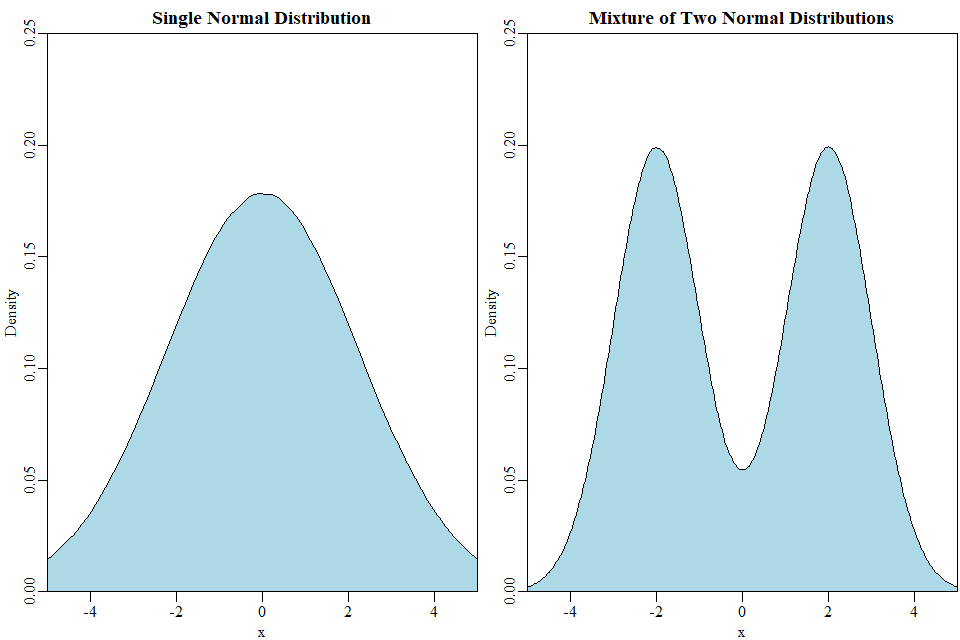If two continuous random variables have exactly the same expected value and variance, do they always have the same distribution?
-
$\begingroup$ this isn't what the OP is asking about but it is a natural generalization of this question and might be of interest: mathoverflow.net/questions/3525/… $\endgroup$– jldCommented Nov 16, 2017 at 4:50
-
1$\begingroup$ Likewise, not exactly what the OP is asking about but demonstrates some very different distributions with essentially-identical mean and stddev: autodeskresearch.com/publications/samestats $\endgroup$– RJHunterCommented Nov 16, 2017 at 5:55
1 Answer
In short: No. There are several properties of a probability distribution that need not affect its mean and variance, but do determine its shape.
Skew & Kurtosis
For example, a Poisson distribution with $\lambda = 1$ has expected value $\lambda = 1$ and variance $\lambda = 1$. So does a normal distribution with $\mu = 1$ and $\sigma^2 = 1$.
An example with two continuous distributions: Take an exponential distribution with $\lambda = 1$, such that its variance is also $\lambda^{-2} = \frac{1}{1^2} = 1$ and compare it to a normal distribution with $\mu = 1$ and $\sigma^2 = 1$. These have the same expected value and the same variance, but look nothing alike and will produce very different numbers:
As to what is different from these distributions with equal mean and variance: Consider the skew and excess kurtosis of the distributions. These are both $0$ for the normal distribution, but not for the exponential distribution.
Multimodality
As @Glen_b pointed out, skew and kurtosis are not the only things to take into consideration. Another example is multimodality: A continuous distribution with multiple modes can have the same mean and variance as a distribution with a single mode, while clearly they are not identically distributed.
For example, consider a mixture of two normal distributions, each with $\sigma^2 = 1$, but their means are $2$ and $-2$, respectively. The resulting mixture will have a mean of $\mu=0$ and a variance of $\sigma^2 = 5$, which is the same expectation and variance as a single normal distribution $\mathcal{N}(0, 5)$:
If you want to try for yourself, this is fairly easy to demonstrate in R:
n <- 10e6 # some arbitrarily large sample size
y1 <- rnorm(n, -2, 1) # mixture component 1
y2 <- rnorm(n, 2, 1) # mixture component 2
y.mixture <- c(y1, y2)
mean(y.mixture)
var(y.mixture)
Versus:
y.single <- rnorm(10e6, 0, sqrt(5)) # R parameterizes with sd instead of var
mean(y.single)
var(y.single)
-
5$\begingroup$ +1 however, you could also have distributions with the same mean, variance, skewness and kurtosis but the distribution shapes might still be quite different $\endgroup$– Glen_bCommented Nov 16, 2017 at 1:55
-
$\begingroup$ Thanks @Glen_b, I added a multimodel example. Are there any important examples I missed (which are continuous)? $\endgroup$ Commented Nov 16, 2017 at 5:18
-
2$\begingroup$ I don't think it's necessary to include additional examples -- your example is great, I meant simply that your answer implied that skewness and kurtosis characterized the case where mean and variance were the same but the distribution shape was different. However, while different distribution shapes often have different skewness and kurtosis they don't have to; you can have the same skewness and kurtosis and different distribution shape -- even with unimodal distributions. $\endgroup$– Glen_bCommented Nov 16, 2017 at 8:57


